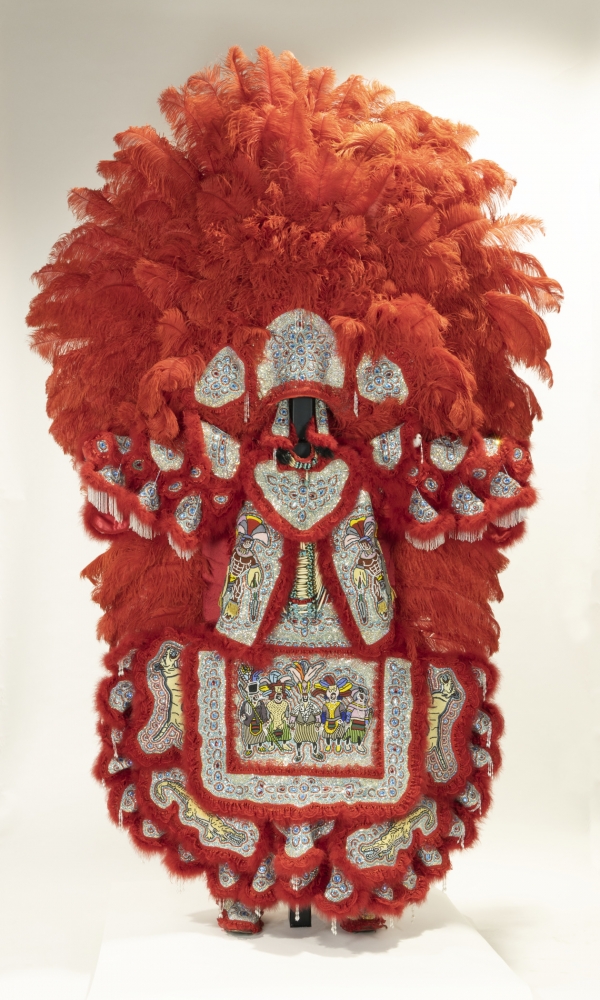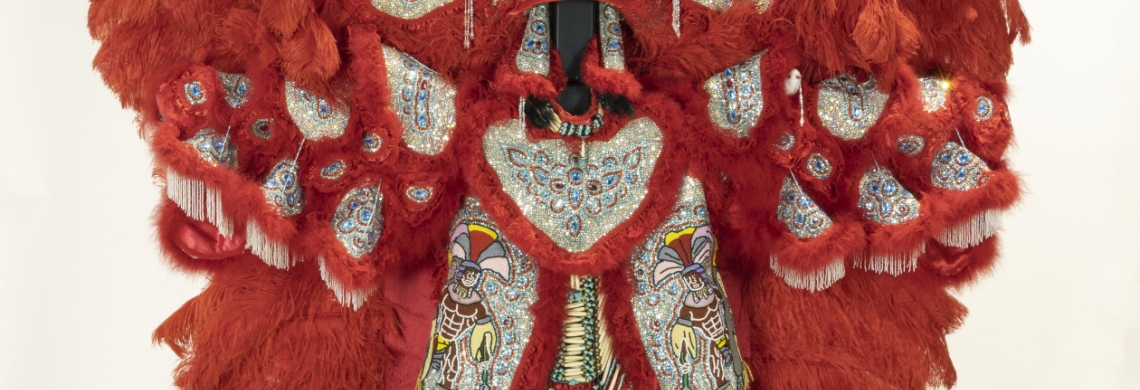For the Use of Museums, Collectors, and Artists
By Loren Brown
Introduction
There are as many different origin stories for Black Masking Indians as there are designs and styles of Black Masking Indian suits. The tradition has been documented since the late 1800s, though it may have begun even earlier. At the center of the tradition is the yearly completion of a new suit, which requires superior craftsmanship and dedication. Many practitioners have described this painstaking process as a spiritual endeavor.
Because of the multifaceted importance of the suits, preservation is not just about maintaining the object—it is also about maintaining the suit’s spiritual integrity. It is essential to maintain suits in a respectful manner, and to seek the opinions of the maker of the suit or members of the Black Masking Indian community as well as a professional conservator when making repairs to a suit or preparing a suit for long-term display and storage. To that end, this guide was created with the help of Big Chief Howard Miller of the Creole Wild West and other members of the Black Masking Indian community. In a joint effort combining museum preservation practices with the expertise of Chief Miller, we have sought to produce a practical and comprehensive guide.
Preservation Challenges
Black masking suits are composite objects, made of a variety of organic and synthetic materials including but not limited to: feathers, shells, beads, sequins, rhinestones, buckram, silk, cotton, polyester, cardboard, ribbon, hot glue, and upholstery thread. Suits are superhuman scale and designed to be worn only on specific ceremonial days in a given year. They are not created with the intention of long-term preservation, which presents several challenges for museums, collectors, and artists.
The greatest threats to the physical preservation of Black Masking Indian Suits are gravity, light, humidity, and pests:
- Gravity can cause feathers to droop and create tears in fabric.
- Light, especially ultraviolet light, causes fading and discoloration in dyed feathers and textiles and can lead to brittleness or delamination in synthetic materials, such as sequins. Light damage is cumulative and cannot be reversed.
- High humidity may encourage mold growth, while large changes in temperature and humidity (going from cold to hot, wet to dry) can cause disparate materials to separate and glue to fail.
- Pests can eat or otherwise destroy objects and leave behind soiling.
Display
- Always display a suit in its entirety and in the same manner it was intended to look on the original wearer.
- Provide enough space for display. Determine how much space will be needed to display the piece by taking measurements of overall height, width and depth. Do not overlap or lean suits against each other.
- Choose an appropriate display stand that will support the suit and maintain its center of gravity. T-stands, made from wood or metal in the form of a cross, can support heavy jackets on the cross bar and have a strong central support for oversized crowns. Tripod or easel stands provide more support for heavy aprons, especially in the three-dimensional style. Mannequins may support suits but may not be strong enough for large or unwieldy crowns. Make sure any stand is stable or braced to the floor to prevent it from falling.
- To prevent tears and ripping, support high stress points by padding display stands and mannequins with breathable fabric or acid-free tissue paper.
- Limit UV light exposure by installing blackout curtains and LED light bulbs.
- Control the temperature and humidity levels. Keep the temperature at or below 70 degrees Fahrenheit. The ideal humidity level is 50 percent, but an average humidity of 40–60 percent is acceptable.
- Allow suits to rest from display at regular intervals. This will prevent feathers from dropping and alleviate stress on the suit. Having suits on permanent display will hasten deterioration from light and gravity.
Storage
- If possible, store suits flat to reduce the pull of gravity. Keep covered with tissue or a natural textile to protect from dust. If the crown is too large for horizontal storage, store on a vertical stand within a closet, framed garment bag, or crate, so that the feathers are not crushed. Jackets and aprons can be hung in breathable garment bags or covered on mannequins.
- Support sleeves with padded hangers and stuff sleeves and boots with acid-free tissue paper. This will help alleviate high stress points and maintain the suit’s natural shape. To prevent bead loss, place tissue paper in between folds where fabric and beads rub together.
- Store suits in a controlled environment with stable temperature (64–72 degrees), humidity (40–60%), and low light exposure.
- When suits cannot be stored in fully dark areas, use UV curtains and LED light bulbs in the storage area.
- Use room dehumidifiers and moisture absorbers to combat high humidity. Monitor temperature and humidty levels to ensure a stable environment.
- Use pest-control supplies such as traps and non-toxic sprays to maintain a pest-free storage area.
Conservation
The goal of conservation is to maintain the integrity of the suit without causing major change. This leads to ethical questions when suits need repairs such as reattaching loose rhinestones or beads or replacing feathers.
- When an institution acquires a suit, it is important to know the opinion of the suit’s creator regarding its conservation. Some may wish to maintain upkeep themselves or keep conservation work within the Black Masking community, while others may not object to outside conservation.
- Black Masking suits are composed of a variety of materials, each with their own needs. It is always best to seek the opinion of the artist as well as a professional conservator about how to best engage with the materials.
- Because of the suits’ unconventional creation, repairs may require unconventional materials. For example, if there is an area where hot glue is failing, you may use hot glue to repair, even though it is not typically used in museum conservation.
Supplies

